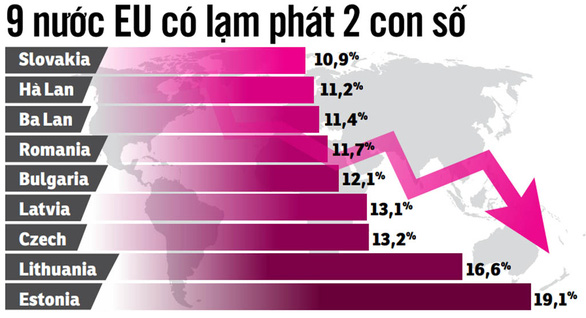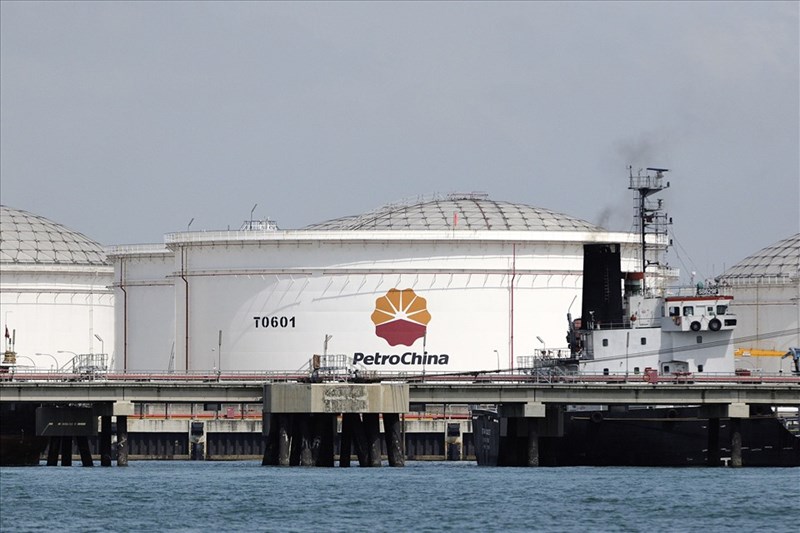Inflation across Europe

Inflation spread throughout Europe – Photo: REUTERS
Consumer prices have increased in every corner of Europe, hindering the bloc’s members’ expectations of economic recovery after the COVID-19 pandemic, while workers are “frustrated” with thousands of worries. rice and clothes.
There is no doubt that the EU economy is going through a challenging period due to the Russia-Ukraine war and we have reduced our growth forecast.
European Commission Vice President Valdis Dombrovskis
Worried about not having enough to eat
Working as a taxi driver in Klaipeda, the third largest city in Lithuania, Antanas Jonauskas clearly feels the direct impact of inflation on daily life.
“With 1 euro now, you can’t even buy a tiny bag of roasted peanuts to fill your stomach. Prices are out of control and there’s no faint hope that it will cool down any time soon,” he said. Jonauskas said.
Jonauskas’ taxi company has allowed the rate increase, but his income has remained the same due to many factors. Tourists are less and less, Russian and Belarusian tourists are absent, while Ukrainians in Lithuania have to measure every penny every time they spend.
Viktoras, the owner of a bakery in Klaipeda, told BNE IntelliNews that he did not rule out the possibility that inflation would force him to close the bakery his parents built.
“Flour prices have skyrocketed, plus wheat supply disruptions are plaguing the market. Damage in Ukraine and sanctions against Russia – the two largest grain exporters in Europe – so we don’t even know what the next fall harvest will be,” said the baker.
From groceries to utilities, rising prices are making it more difficult for wage earners to shop.
Vytautas Snieska, professor of economics at the faculty of economics and commerce at Kaunas University of Technology (Lithuania), said in the context of prices paid for goods and services that serve basic needs such as heating and food products have increased, those with low income are the most affected.
“It’s as simple as this, if in the past they were struggling to make ends meet, with the current high prices due to inflation, they have no choice,” said Snieska expert.
When Tuoi Tre contacted to ask about inflation and cost of living, Trinh Tuyet Linh, who lives in the Netherlands, said that inflation in the Netherlands is also very high, 9.6% in April 2022. Prices of many industrial products have increased by more than 1/3 due to the price of input materials such as metal, paper, fertilizer… also increased sharply.

(Statistics April 2022 of Eurostat) – Data: HONG VAN – Graphic: N.KH.
Energy pulls prices up
One-third of EU countries have inflation of 10% or more, of which Baltic countries such as Estonia, Lithuania and Bulgaria have the highest increases in consumer prices.
According to the European Statistics Agency (Eurostat), the annual inflation in April 2022 in Estonia topped the whole bloc with 19.1%. Electricity and gas prices in this country increased at the highest rate in the whole EU.
The Estonian statistics agency said that in April 2022, energy prices increased by 38%, followed by prices of food, alcohol, tobacco, goods and services. Outside the EU, in the UK, inflation in April 2022 of this kingdom was 9%, the highest level in 40 years.
The common point of inflation in European countries, whether inside or outside the EU, is due to rising energy prices – a consequence of the Russia-Ukraine conflict.
According to Eurostat, energy prices account for more than half of Europe’s overall annual inflation rate of 7.4%. Meanwhile, in 2021, inflation here is only 1.6%. Sanctions against Russia and Russia’s retaliatory measures also caused gasoline, oil and gas prices to rise globally.
The European Commission (EC) forecasts that the EU economy as a whole could grow at only 2.7% this year, 1.3% lower than estimates before the Russia-Ukraine conflict broke out. .
The Bank of England (BoE) and other central banks of Europe have had to raise interest rates to curb inflation despite facing the risk of an economic recession. In Europe, the eurozone grew by just 0.4% in the first quarter of 2022, suggesting a recession is real.
Speaking to the Guardian newspaper, EC vice-president Valdis Dombrovskis said the war in Ukraine hurt the EU’s economic growth.
“The overriding negative factor is soaring energy prices, which have sent inflation to record highs, putting strain on businesses and households in Europe. Although the EU will still grow this year and next, the level of growth is still limited. growth will be much lower than previously expected,” said Dombrovskis.
at Blogtuan.info – Source: tuoitre.vn – Read the original article here



